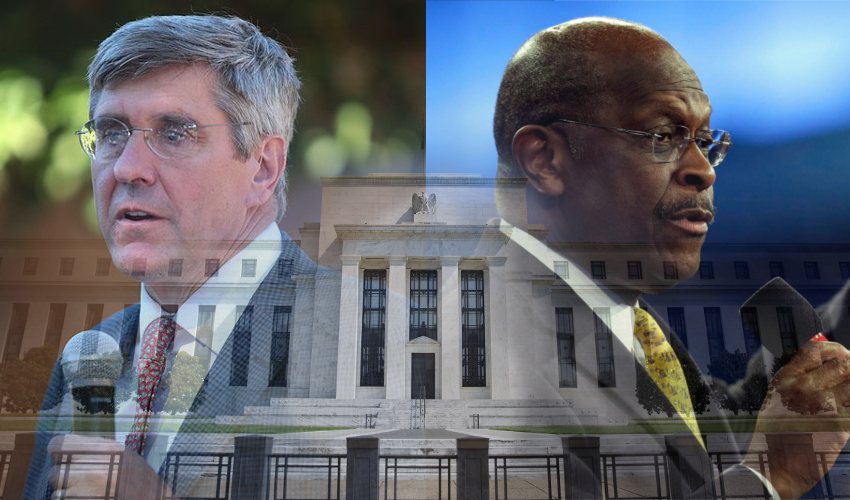Stephen Moore, Herman Cain, and the Myth of Independence
President Trump has announced plans to nominate Stephen Moore and Herman Cain to fill the two remaining vacancies on the Federal Reserve’s Board of Governors. In response, many have expressed concern about the central bank’s independence should Moore and Cain be confirmed by the Senate.
Moore is a budgetary economist with no experience in monetary policy or financial-markets regulation. Cain fares better on the experience margin, having served as member, deputy chairman, and chairman of the Kansas City Fed’s board of directors in the early to mid-1990s. But his views on monetary policy have been described as “unpopular — and ultimately impractical.” Both, however, have been loyal to President Trump, which seems to explain their nominations.
When debating the merits of Moore and Cain, there is a temptation to start from the position that the Fed is — and has been — independent. Writing in The Atlantic, Peter Nicholas claims the president “seems determined to assemble a more compliant board, even if it means intruding on the Fed’s historic independence.” White House economic advisor Larry Kudlow insists that “[t]he Fed is independent. We are not trying to compromise that independence. Never will.” Others have questioned whether the Fed’s historical independence is so desirable after all. The mistake in all of these views, however, is the same: the Fed is not — and has never been — independent. It is not even independent relative to other central banks.
The history of the Fed is replete with political meddling. Prior to the Banking Act of 1935, the secretary of the Treasury served as ex officio chairman of the Federal Reserve Board. Marriner Eccles, the first modern Fed chair, wrote much of the act while working under Henry Morgenthau Jr. at the Treasury. The Fed continued to be guided by Treasury policy with Eccles as chair. And when the chairman ultimately broke rank under President Truman, he was not reappointed for another 4-year term (though he served out the remainder of his 14-year term as governor).
In January 1951, as inflationary pressure had prompted the Fed to tighten monetary policy, President Truman “called the entire FOMC to a meeting in the White House at which he ‘demanded’ that the committee continue to support U.S. bond prices.” Then, following the meeting, the White House announced that the FOMC agreed to follow the president’s preferred course of action. It had not. But then-Chairman Thomas McCabe did not push back.
The examples of executive interference go on and on. President Johnson consulted with Attorney General Nicholas Katzenbach about firing Fed Chair William McChesney Martin. President Nixon pressured Chair Arthur Burns to use monetary policy to support his reelection bid. “In that sense,” Neil Irwin writes, “there is nothing new in President Trump’s aggressive approach to the Fed.”
Of course, the Fed is also subject to political influence from Congress. Since 1978, the Fed chair has been required to prepare a report for Congress and offer oral testimony before the Committee on Banking, Housing, and Urban Affairs of the Senate and the Committee on Financial Services of the House of Representatives twice per year. Those serving on the committees can use this time to harangue the Fed chair for pursuing policies not to their liking. And that prospect appears to influence monetary policy.
While acknowledging the lack of historical independence, some suggest President Trump goes too far in nominating “two officials with a background in partisan politics.” But even this is a matter of degree. Presidential appointments are political appointments. And every president, when given the chance, appoints a governor likely to deliver the kind of monetary policy the president wants.
Just consider recent Fed chairs. Alan Greenspan advised President Nixon (R) and then chaired the Council of Economic Advisers under President Ford (R) before President Reagan (R) made him Fed chair. Ben Bernanke was appointed to the Board of Governors by President George W. Bush (R), left to chair the president’s Council of Economic Advisers, and then returned to chair the Fed when the same president nominated him. Janet Yellen chaired the Council of Economic Advisers under President Clinton (D). She was later appointed vice chair and then chair of the Fed by President Obama (D).
The current Fed chair, Jerome Powell, served as undersecretary of the Treasury for domestic finance under President George H.W. Bush (R). He was appointed to the Fed’s Board of Governors by President Obama (D) and then elevated to Fed chair by President Trump (R). That appears to conflict with the view put forward here. But it does not. Powell’s nomination to the Board of Governors was paired with that of President Obama’s preferred candidate, Jeremy Stein. Stein’s nomination had previously been filibustered, and few think he would have been confirmed had the president not offered the pairing. In any event, it was the first time a president had nominated a member of the opposition party for a seat on the Fed board in more than 20 years. That’s politics, folks.
The president’s decisions to nominate Stephen Moore and Herman Cain leave a lot to be desired. Their monetary policy views are simplistic at best, counterproductive at worst. And they would almost certainly reduce the Fed’s independence. But that is no excuse for perpetuating the myth that the Fed has been independent up until now.










